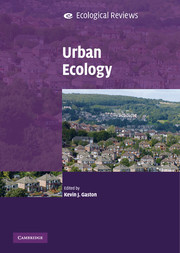Book contents
- Frontmatter
- Contents
- List of contributors
- Preface
- 1 Urban ecology
- 2 Urbanisation
- 3 Urban environments and ecosystem functions
- 4 Individual species and urbanisation
- 5 Species diversity and urbanisation: patterns, drivers and implications
- 6 Urbanisation and alien invasion
- 7 Interactions between people and nature in urban environments
- 8 Urban ecology and human social organisation
- 9 Urban ecology and human health and wellbeing
- 10 Bringing cities alive: the importance of urban green spaces for people and biodiversity
- 11 Integrating nature values in urban planning and design
- 12 Urban futures
- Index
- References
11 - Integrating nature values in urban planning and design
Published online by Cambridge University Press: 05 June 2012
- Frontmatter
- Contents
- List of contributors
- Preface
- 1 Urban ecology
- 2 Urbanisation
- 3 Urban environments and ecosystem functions
- 4 Individual species and urbanisation
- 5 Species diversity and urbanisation: patterns, drivers and implications
- 6 Urbanisation and alien invasion
- 7 Interactions between people and nature in urban environments
- 8 Urban ecology and human social organisation
- 9 Urban ecology and human health and wellbeing
- 10 Bringing cities alive: the importance of urban green spaces for people and biodiversity
- 11 Integrating nature values in urban planning and design
- 12 Urban futures
- Index
- References
Summary
Introduction
In several chapters of this book it is emphasised that urban ecosystems are under constant threat by ongoing urbanisation, by biological invasions and by human use. Other chapters, however, highlight the specific character of urban ecosystems (that by definition is indicated by the dominant role of urban dynamics) and their importance to human wellbeing and quality of life. This divergence illustrates two fundamentally different views of urban ecosystems: as remnants of (previously extensive) natural ecosystems threatened by ongoing human pressure, or as green patches with high use value to people who work and live in the city landscape. From the first perspective urban ecosystems are separated as much as possible from the urban system, and from the second they are an essential part of that system.
These divergent views on urban ecosystems illustrate the type of debate that can be expected from the variety of participants in an urban planning process. They may hold opposing views and economic stakes, but have to develop a common position on the desired future of the urban landscape, and what it would take to achieve this. In this chapter we consider how both the conservation (in terms of defending pieces of highly valued ecosystems against undesired changes) and the enhancement (in terms of creating additional ecological, social or economic value) of urban ecosystems can be integrated into decision making on urban development.
- Type
- Chapter
- Information
- Urban Ecology , pp. 261 - 286Publisher: Cambridge University PressPrint publication year: 2010
References
- 9
- Cited by



